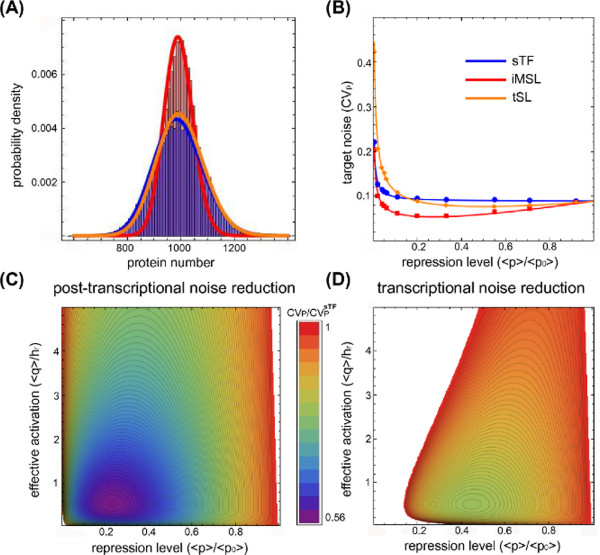Figure 5.
Intronic miRNAs can buffer noise in host gene expression.(A) An example of the target protein distributions for the three circuits (repression level 〈p〉/〈p0〉=0.2). Lines are gamma distributions with first two moments calculated analytically, while histograms are the result of Gillespie simulations. The distribution for the iMSL circuit (red line and histogram) is the narrowest, showing that, even if also a tSL (orange line and histogram) can reduce noise with respect to a sTF (blue line and histogram), the iMSL is outperforming. (B) Target noise CVp as a function of the repression level 〈p〉/〈p0〉 for the three circuits. Lines are analytical predictions, while dots are the result of Gillespie simulations. Given a noise level CVq ≃ 0.2 in the upstream transcription factor, both the iMSL (red lines and dots) and the tSL (orange line and dots) shows a minimum of noise reduction with respect to the sTF (blue line and dots), but the level of fluctuations in the iMSL case is clearly lower. (C,D) Noise reduction on the target protein level achieved by the iMSL and the tSL respectively. The noise reduction (where measures the fluctuations around the same mean level for a sTF) is evaluated at different degrees of transcriptional activation 〈q〉/hr and repression 〈p〉/〈p0〉. The same color gradient is used in both heat maps, showing that the iMSL reduces fluctuations on a larger parameter region and to a greater extent. In the white regions . The parameter values are the following: mRNA half-life τr = τw = 30 minutes, protein half-life τp = τq = 1.5 hours, kw = 3.410−3s−1, kq = 8.710−3s−1, kr = 0.155s−1, kp = 4.810−3s−1(see Additional file 1 for the definition of kw and kq).

